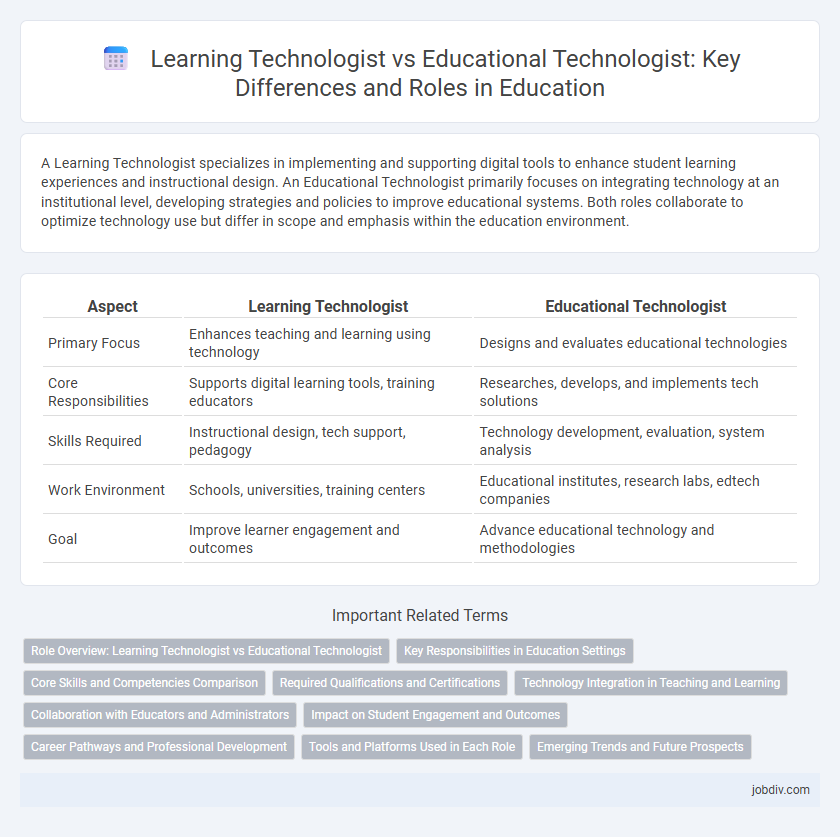A Learning Technologist specializes in implementing and supporting digital tools to enhance student learning experiences and instructional design. An Educational Technologist primarily focuses on integrating technology at an institutional level, developing strategies and policies to improve educational systems. Both roles collaborate to optimize technology use but differ in scope and emphasis within the education environment.
Table of Comparison
| Aspect | Learning Technologist | Educational Technologist |
|---|---|---|
| Primary Focus | Enhances teaching and learning using technology | Designs and evaluates educational technologies |
| Core Responsibilities | Supports digital learning tools, training educators | Researches, develops, and implements tech solutions |
| Skills Required | Instructional design, tech support, pedagogy | Technology development, evaluation, system analysis |
| Work Environment | Schools, universities, training centers | Educational institutes, research labs, edtech companies |
| Goal | Improve learner engagement and outcomes | Advance educational technology and methodologies |
Role Overview: Learning Technologist vs Educational Technologist
Learning Technologists specialize in integrating digital tools and pedagogical methods to enhance student learning experiences and support instructional design. Educational Technologists focus on the broader implementation and management of educational technologies within institutions, including infrastructure, training, and evaluation of technology use across curricula. Both roles require expertise in technology and education, but Learning Technologists prioritize learner outcomes while Educational Technologists emphasize systemic technology integration.
Key Responsibilities in Education Settings
Learning Technologists specialize in designing, implementing, and evaluating digital learning tools and resources to enhance student engagement and improve educational outcomes. Educational Technologists focus on integrating technology into curriculum development, conducting training for educators, and managing educational technology infrastructure in schools or universities. Both roles prioritize optimizing teaching and learning processes through technology but differ in scope, with Learning Technologists more involved in user experience and content, while Educational Technologists address broader institutional technology strategy and support.
Core Skills and Competencies Comparison
Learning Technologists specialize in designing and implementing digital learning environments, emphasizing instructional design, e-learning tools, and learner engagement analytics. Educational Technologists focus on broader educational infrastructure, integrating technology across curricula, managing learning management systems, and supporting pedagogical strategies. Core competencies for Learning Technologists include multimedia development, user experience design, and adaptive learning technologies, whereas Educational Technologists excel in technology policy, training educators, and aligning tech solutions with educational goals.
Required Qualifications and Certifications
Learning Technologists typically require a background in education or instructional design, often holding degrees in education technology or related fields, alongside certifications such as Certified Professional in Learning and Performance (CPLP). Educational Technologists usually possess qualifications in educational technology, computer science, or curriculum development, with certifications like CompTIA CTT+ or Google Certified Educator enhancing their credentials. Both roles benefit from continuous professional development to stay current with evolving digital tools and pedagogical strategies.
Technology Integration in Teaching and Learning
Learning Technologists specialize in integrating digital tools and platforms to enhance student engagement and personalized learning experiences, often working directly with educators to implement innovative instructional strategies. Educational Technologists focus on the broader application of technology in curriculum design, assessment, and institutional planning to improve overall educational outcomes. Both roles contribute to technology integration, but Learning Technologists emphasize practical classroom solutions, while Educational Technologists address systemic and pedagogical frameworks.
Collaboration with Educators and Administrators
Learning Technologists collaborate closely with educators to design and implement effective digital learning experiences, focusing on pedagogical strategies and student engagement. Educational Technologists work alongside administrators to integrate technology infrastructure and policy, ensuring scalable and sustainable solutions within educational institutions. Both roles require strong communication skills and a collaborative mindset to align technology with teaching goals and institutional objectives.
Impact on Student Engagement and Outcomes
Learning Technologists focus on integrating digital tools and instructional design to directly enhance student engagement and improve learning outcomes. Educational Technologists emphasize broader systemic change by developing strategies and policies that support technology use across educational institutions. Both roles contribute significantly to improved student performance, but Learning Technologists have a more immediate impact on individual learner interaction and motivation.
Career Pathways and Professional Development
Learning Technologists primarily focus on integrating digital tools to enhance teaching and learning experiences, often collaborating directly with educators to design innovative instructional strategies. Educational Technologists tend to engage more broadly in research, policy development, and the implementation of large-scale educational technologies across institutions. Career pathways for Learning Technologists typically involve roles in instructional design and faculty support, while Educational Technologists often pursue positions in educational research, technology administration, and strategic planning, with professional development emphasizing continuous technological skill enhancement and pedagogical expertise.
Tools and Platforms Used in Each Role
Learning Technologists primarily use instructional design software, learning management systems (LMS) like Moodle and Canvas, and authoring tools such as Articulate Storyline to create and implement engaging digital learning experiences. Educational Technologists focus on broader institutional technology integration, utilizing platforms for data analytics, campus-wide digital infrastructure, and communication systems like Microsoft Teams and Zoom to support teaching and administration. Both roles require proficiency with collaborative tools, but Learning Technologists emphasize learner-centered technologies while Educational Technologists manage systemic educational technology deployment.
Emerging Trends and Future Prospects
Learning Technologists focus on integrating innovative digital tools to enhance student engagement and personalized learning experiences, emphasizing user-centered design and adaptive technologies. Educational Technologists typically address broader institutional strategies, including curriculum development, technology policy, and system-wide implementation of emerging platforms like AI-driven analytics and virtual reality. Both roles are evolving rapidly with trends in immersive learning environments, data-driven decision making, and increasing demand for scalable, remote education solutions.
Learning Technologist vs Educational Technologist Infographic

 jobdiv.com
jobdiv.com